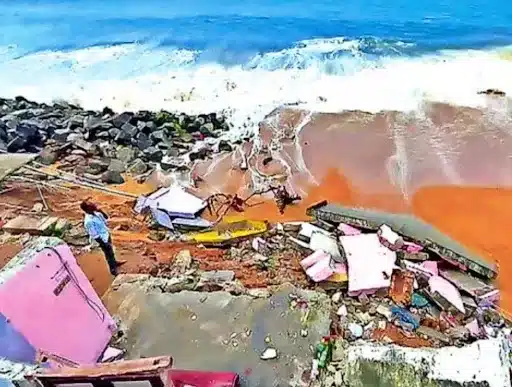What’s in today’s article?
- Why in News?
- What’s in Today’s Article?
- Kallakkadal
- What causes Kallakkadal?
- Kallakkadal – challenges in early preparedness
- Why is Kallakkadal different from tsunami?
Why in news?
Recently, hundreds of houses have been flooded in several coastal areas of Kerala due to high sea waves, also known as swell waves. The worst affected regions include Alappuzha, Kollam, and Thiruvananthapuram districts.
Such flooding events are called swell surge or Kallakkadal in Malayalam.
What’s in today’s article?
- Kallakkadal
Kallakkadal
- About
- Kallakkadal is essentially coastal flooding during the pre-monsoon (April-May) season by swell waves on the southwest coast of India.
- Meaning
- The term Kallakkadal, used by local fishermen, is a combination of two Malayalam words, including Kallan and Kadal.
- Kallan means thief and Kadal means sea. Meaning ocean that arrives as a thief.
- In 2012, the term was formally approved by the United Nations Educational, Scientific and Cultural Organization (UNESCO).
What causes Kallakkadal?
- Ocean swell and role of distant storms
- Kallakkadal is caused by waves that are formed by an ocean swell, hence the name swell surge.
- Ocean swells occur not due to the local winds, but rather due to distant storms like hurricanes, or even long periods of fierce gale winds.
- During such storms, huge energy transfer takes place from the air into the water, leading to the formation of very high waves.
- Such waves can travel thousands of kilometres from the storm centre until they strike shore.
- Formation of Kallakkadal
- Kallakkadal is a consequence of the strong winds in the southern part of the Indian Ocean, where an ocean swell is generated.
- These generated waves then travel north to reach the coast in two/ three days.
- Recent incidents of Kallakkadal
- The latest instance took place after a low atmospheric pressure system moved over the region around March 25 from the South Atlantic Ocean — 10,000 kilometres off the Indian coast.
- The arrival of the pressure system resulted in strong winds, which led to the formation of swell waves of up to 11 metres in height.
Kallakkadal – challenges in early preparedness
- Kallakkadal occurs without precursors or any kind of local wind activity and as a result, it has been very difficult for the coastal population to get an advance warning.
- However, early warning systems like the Swell Surge Forecast System gives forewaring seven days in advance.
- This system was launched by the Indian National Centre for Ocean Information Services (INCOIS) in 2020.
Why is Kallakkadal different from tsunami?
- Kallakkadal is a flash flood event that occurs without any noticeable change in local winds. On the other hand, tsunami is a series of enormous waves created by an underwater disturbance.
- Other differences include:
- Cause: Kallakkadal is caused by strong winds, while tsunamis are caused by earthquakes.
- Wave height: Tsunamis have a small wave height offshore.
- Wavelength: While ocean waves have a wavelength of only 30 or 40 meters, Tsunamis have a very long wavelength often hundreds of kilometers long.
Q.1. What is Indian National Centre for Ocean Information Services (INCOIS)?
The Indian National Centre for Ocean Information Services (INCOIS) is an autonomous organization of the Government of India that provides ocean information and advisory services to society, industry, government agencies, and the scientific community. INCOIS was founded in 1999 and is located in Pragathi Nagar, Hyderabad.
Q.2. What are swell waves?
Any random disturbance that can occur in the sea. Swell waves are specific kinds of deep-water, linear, long-range wind-driven waves that emanate or filter out of a random wave system during an external weather event due to wave dispersion. Waves can be of any form, type, shape, height, period, direction, and speed.
Source: What is Kallakkadal, which has flooded houses in Kerala’s coastal areas?
Last updated on December, 2025
→ Check out the latest UPSC Syllabus 2026 here.
→ Join Vajiram & Ravi’s Interview Guidance Programme for expert help to crack your final UPSC stage.
→ UPSC Mains Result 2025 is now out.
→ UPSC Notification 2026 is scheduled to be released on January 14, 2026.
→ UPSC Calendar 2026 is released on 15th May, 2025.
→ The UPSC Vacancy 2025 were released 1129, out of which 979 were for UPSC CSE and remaining 150 are for UPSC IFoS.
→ UPSC Prelims 2026 will be conducted on 24th May, 2026 & UPSC Mains 2026 will be conducted on 21st August 2026.
→ The UPSC Selection Process is of 3 stages-Prelims, Mains and Interview.
→ UPSC Result 2024 is released with latest UPSC Marksheet 2024. Check Now!
→ UPSC Prelims Result 2025 is out now for the CSE held on 25 May 2025.
→ UPSC Toppers List 2024 is released now. Shakti Dubey is UPSC AIR 1 2024 Topper.
→ UPSC Prelims Question Paper 2025 and Unofficial Prelims Answer Key 2025 are available now.
→ UPSC Mains Question Paper 2025 is out for Essay, GS 1, 2, 3 & GS 4.
→ UPSC Mains Indian Language Question Paper 2025 is now out.
→ UPSC Mains Optional Question Paper 2025 is now out.
→ Also check Best IAS Coaching in Delhi

















